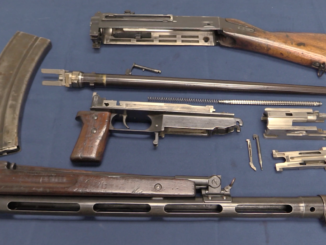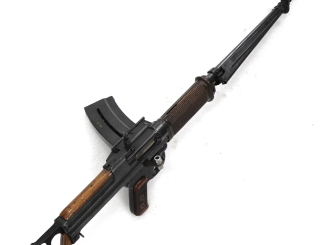The Swiss military dabbled in revolvers with their rimfire 1872 model (about 900 made) and the followup 1878 centerfire version (5500-6000 made), but their first large-scale service revolver was the Model 1882, designed by Colonel Schmidt (yeah, the same guy who did the rifles). The 1882 is a 7.5mm, 6-shot double action design with lineage to the French 1873 model. It is a magnificently well-made gun (of course; it IS Swiss after all), and features several nice features.
It has a rebounding hammer, allowing it to be safely carried with all 6 chambers loaded. It also uses the Abadie gate-loading system, in which opening the loaidng gate disconnects the trigger from the hammer. This allows the trigger to be used to quickly and precisely index the cylinder between chambers when loading and unloading. For gate-loading wheelguns, this makes it the fastest type to load and unload. It also has a hinged sideplate, which opens up with the removal of a single captive screw, allowing easy access to all the internals – which are helpfully numbered in their disassembly order.
Overall it is an excellent gun, if underpowered by today’s standards (and very difficult to find ammunition for).




bingo! another great revue of a very interesting gun
many thanks, jerry
Side arms for officers generally serve as symbols of rank, so they aren’t expected to be powerful enough for 50 foot one-shot stops. But getting within bad breath range of the officer’s revolver is clearly suicidal.
“very difficult to find ammunition for”
Municion query:
http://www.municion.org/7_5x23R/7_5x23R.htm
looking at dimensions it might be probably possible to use .32 S&W [Short] in Ordonannz-Revolver M 1882 if thicker rim wouldn’t be obstacle, but this need experimental prove (or deny)
(7.5 Swiss vs .32 S&W: base diameter: 9.09mm vs 8.58mm, rim diameter: 10.34mm vs 9.50mm, rim thickness: 1.08mm vs 1.42mm)
Considering altering existing cartridge cases, .32-20 seems quite suitable
Municion states following ballistic for 7.5mm Swiss revolver:
muzzle velocity: 200 m/s with 100gr (6,5g) bullet (black-powder)
thus ballistic-wise it is close to .32 S&W Long
I found site about hand-loading 7.5mm Swiss cartridge, but in Deutsch:
http://www.vsms.org/Forum/Seite_23/forum_23_7.5mmCH_Ord.htm
it states that around 2012 Fiocchi produced small batch of 7.5 ORD SVIZZERA cartridge, despite one 50-examples-box cost was 100 CHF it was fast bought-out.
7.5mm Swiss can be crafted from .32-20 or .25-20 cases.
“rimfire 1872 model (about 900 made) and the followup 1878 centerfire version (5500-6000 made)”
http://waffenfan.com/fachberichte/48-pistol/52-ordonnanz-revolver-m-1882 states that Ordonnaz-Revolver M.1882 was produced in quantity:
37254 for Army by W+F (serial numbers: 1-37254)
? for authorities (judicial officers, police etc.) by W+F with “P” letter before serial number
? for private market by SIG, serial numbers without “P”, have text “Waffenfabrik Neuhausen” or “Fabrique d’armes Neuhausen”
As far as its “stopping power” goes, Cartridges of the World (13th ed.) lists the military load as 102 to 110 grain lead bullet at 700 F/S for 115 FPE.
This is a near-exact ballistic “twin” of the standard modern factory smokeless-powder load for the .32 S&W; 98 grain lead bullet at 705 F/S for, again, 115 FPE.
Not a .327 Federal Magnum by any means, but powerful enough to get the job done provided you hold up your end of the bargain and shoot for the vitals.
cheers
eon
I suspect that the paltry ballistics of European small-bore revolvers is because their intended use was to deliver a “coup de grace” to some unfortunate recently mown down by a firing squad… In other words, much like a trapper would use a .32 S&W to prevent damaging the expensive pelt of a trapped fur-bearing creature, the “offizier” would put a tiny bullet into the medula or brain stem of some recently executed “soldat.” A “badge of rank” and symbol of authority, but little else. Oh. And the crippled ponies of the cavalry too.
“trapper would use a .32 S&W”
Also notice that for this usage, .32 S&W is light, which mean less mass for same quantity of examples (which is important when your mode of transportation is foot-slogging)
Good looking gun; I would not mind to own it even with that “anemic” cartridge.
One word of caution, not all revolvers with rebounding hammers are drop-safe.
Although this design may put solid steel between the hammer and frame somehow, many older double action revolvers with rebounding hammers have only the flimsy rebounding mechanism to keep the firing pin from striking the primer if the revolver is dropped on the hammer spur.
Think of it as similar to the Colt Single Action Army. That revolver has a “safety notch” on the hammer that keeps the firing pin from resting on the primer, but the mechanism is not strong enough to ensure that it won’t break if the revolver is dropped on the hammer spur, driving the firing pin into the primer with adequate force to discharge the round.
Be careful out there!
This one is however, quite as were most European rebounding hammer revolvers – Nagant, Gasser, Webleys etc. Colt SAA has only a tiny notch compared to this quite positive block. Also note that due the way it is made, even if part breaks off it would still block a hammer from falling down.
Damn. Another one I have to chase down and buy.
Ian did a video recently about a ground off firing pin on a french 1874 revolver where the parts were wildly off. Does anyone know whether the legendary Swiss quality includes interchangeable parts.
7.5mm Swiss? 7.5mm Swedish? Hooray, Swederland!
I was trolling through fortress videos about Switzerland and happened upon a great military exercise vid from the 1970s… The “home team” (De-fence! De-fence!) had the 1918 Swiss helmets and Alpenflage camo uniforms and Stgw. 57 rifles while the “away team” had the 1971 steel helmets and Suomi SMGs! Sure wish I could find it now…
My uncle has passed away and this gun was in his collection, WOW!
It is in great shape and I cant wait to shoot it. Is there a collector value for this gun?
Does anyone have the deminsions of the cartridge?
After locating the dimensions of the cartridge, I [urchased some 32-20 Winchester brass and trimmed to a length of 0.89 inch. For bullets I used RCBS 98gr SWC sized to 0.314 inch. The load I developed was 3.4gr Unique, standard primers and a OAL of 1.29 inches. Average velocity was 850 FPS. A very pleasant round to shoot. IMO asccuracy was quite acceptable – 28 shot group 1.5″ x 2.0″ at 21 feet off hand.
x